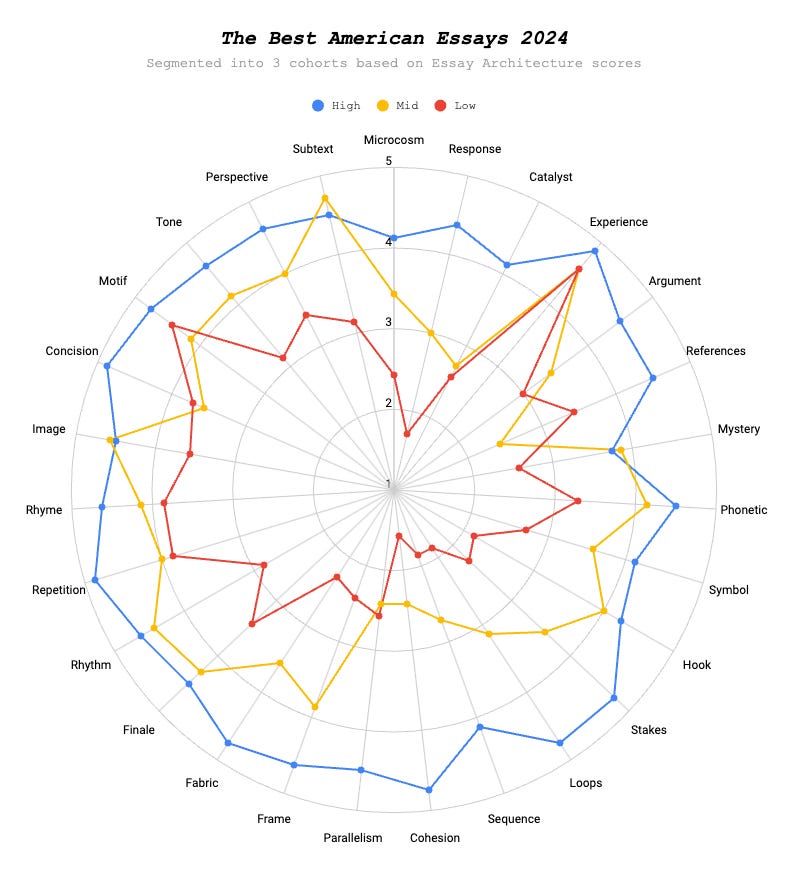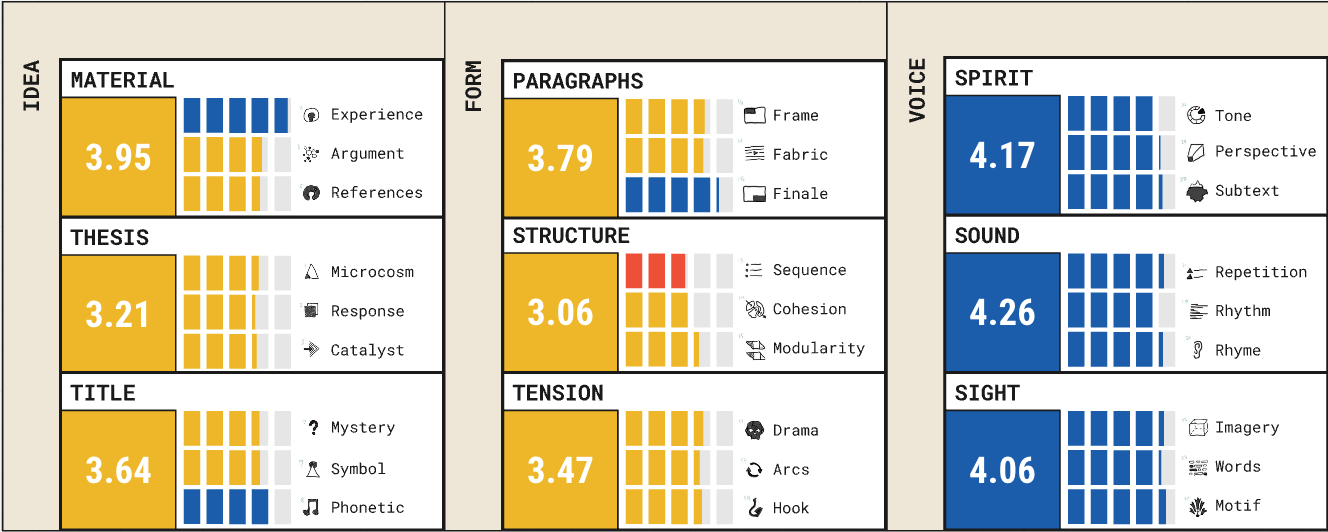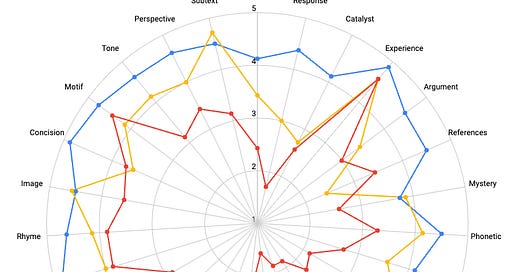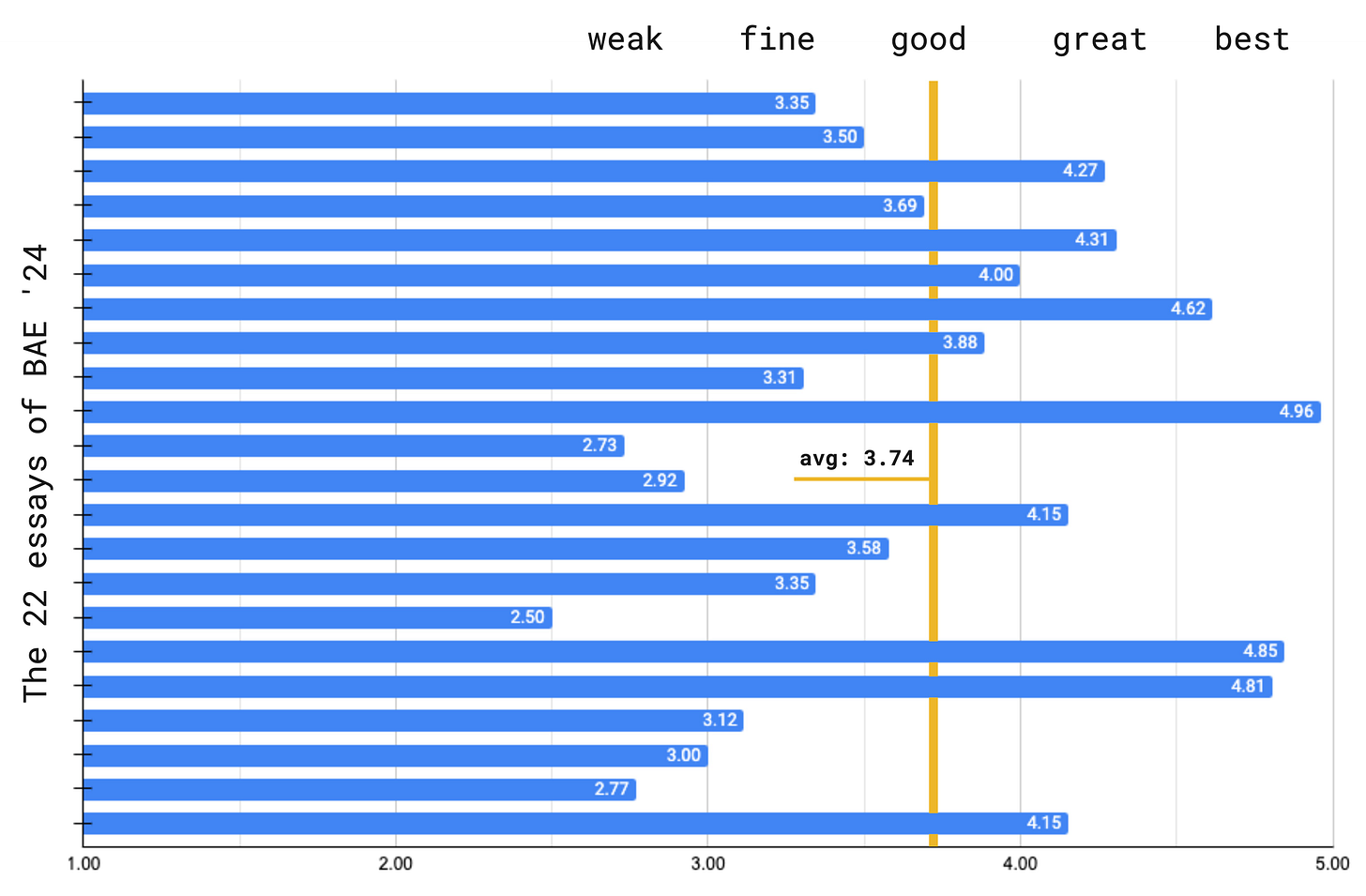
As a fan of The Best American Essays (BAE) series—who recently bought all 39 editions on thriftbooks.com for $219—it’s hard for me to write a review of the 2024 edition that casts any doubt on the project or process.
You likely already know that I’ve been reading, analyzing, and scoring essays, and so BAE is an invaluable resource for me. Starting in 1986, Robert Atwan would maniacally1 read thousands of essays per year across hundreds of American periodicals, creating a longlist of +100 so the final selection of ~25 can be made by the yearly guest editor (a pantheon which includes Susan Sontag, Annie Dillard, Mary Oliver, Cheryl Strayed, David Foster Wallace, etc.). Each edition has an introduction where the guest shares their thoughts on the essay. I bought this collection so I could binge those intros. I also wanted a physical essay silo.
I just finished the 2024 edition—which involved me manually scoring 22 essays on composition, each out of a possible 135 points. I have good news and bad news:
The good news is that the process works (sort of). As imperfect as it may be, it does its job of surfacing essays that live up to the promise of the collection: some of these are among the best I’ve ever read. I recommend you buy the book, even if only to access the top few (I have links below, but they require subscriptions or physical journals):
The Ones We Sent Away, Jennifer Senior (4.96 of 5)
As Big As You Make It Out to Be, Austin Woerner (4.81 of 5)
Memory’s Cellar, James McAuley (4.81 of 5)
Proxemics, Jonathan Gleason (4.63 of 5)
The bad news is that I now have data to confirm my suspicion: the essay has been swallowed by memoir. This collection reads like a series of short memoirs, some of which happen to be essays. Of course, each genre has merits and the two have overlap (ie: the personal essay), but one shouldn’t eclipse the existence of the other. When you over-index on Experience and Voice, it leads to a collection that is compositionally lopsided. Some of them integrate memoir and essay masterfully. Most don’t.
The 2024 edition as a whole scored a 3.74 out of 5, with four essays in the 2s.
It would be more apt to call this “Best American Flash Memoirs 2024,” or even, “Good American Essays 2024.”
If you are befuddled at the idea of objectively scoring composition, you can start with The secret architecture of great essays or A Pattern Language. Basically, I mapped out 27 patterns, along with rubrics to score each one 1-5. Of course, there are sub-genres which prioritize some patters over others. But if there were to be a single place where we celebrate the incredibly hard act of synthesizing everything (all sides of the psyche) it should be an essay anthology. That’s not what’s happening in this edition.

The purpose of this review isn’t to knock the series or complain. Rather, I think the project is too important to not critique. This is the only annual essay anthology our culture has.2 My hope is to start a productive and ongoing debate3 among essay nerds that spirals into a new vision for the role of anthologizing.
Today we’ll cover:
What BAE means by “best”;
Why a definition of the essay is important;
The potential of an annual anthology.
There will be graphs.
In the spirit of dedicating a monthly post to the paying believers of Essay Architecture, the rest of this one is locked. If you’re not ready for that, I understand, and hope you still check out BAE ‘24. If you want a monthly deep dive on the craft and culture around essays, this is your place.
What BAE mean by “best” (1):
What makes an essay the “best”? In lieu of a static definition, The Best American series4 relies on a rotating guest editor so there’s a range of perspectives. So how does Wesley Morris define peak quality in 2024? We have to read between the lines of his introduction. He says great essays are works where the author “has the nerve to offer themself,” and where “every sentence is a risk,” rendered through “marvels of memory … [and] voice.” These are all great tenets: Be courageous. Own your identity. Share your story. But when these become the primary selection filters, it leads to a collection that’s less about quality and more about pain.
This year’s anthology doesn’t select for composition, but topic—vulnerable topics. What will you find across these 22 essays? 68% of the collection had death as its main theme: there is the death of people (a mother, two brothers, a son, aunt, and friend), the death of animals (a bird, a horse, and many dogs), the death of a tree, the death of the masses (4x), and also the thought of death (suicide). The remaining essays tap into miscellaneous vulnerabilities (racism, jail, child rape, panic attacks, glory holes, gender surgery, and a married couple that boxes each other).
A Goodreads review framed this edition (positively) as: “Tragic experiences, communicated in artful ways.” This is the perfect caption for my pattern graph…
Keep reading with a 7-day free trial
Subscribe to Essay Architecture to keep reading this post and get 7 days of free access to the full post archives.




